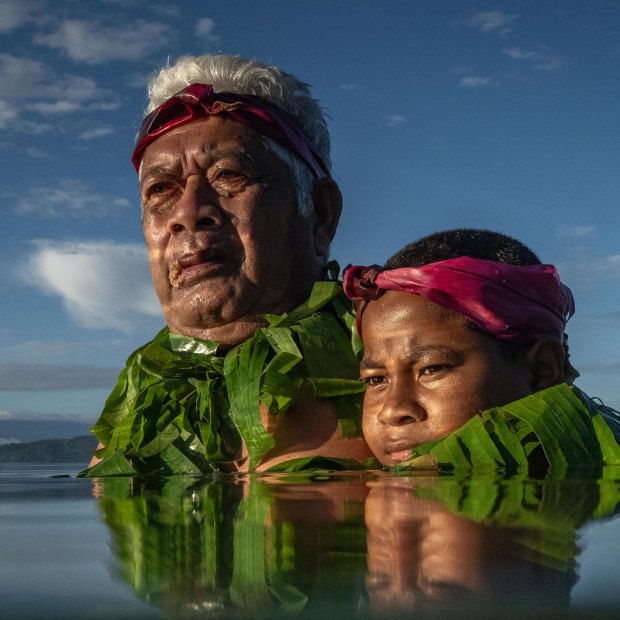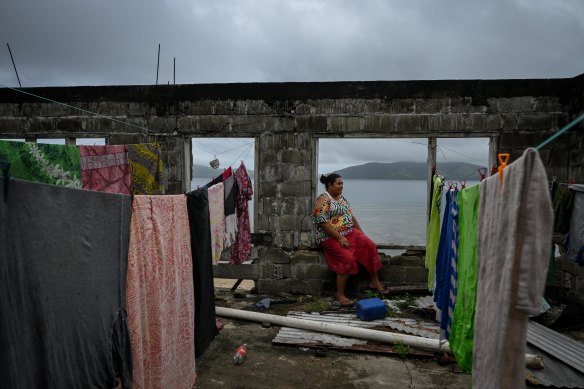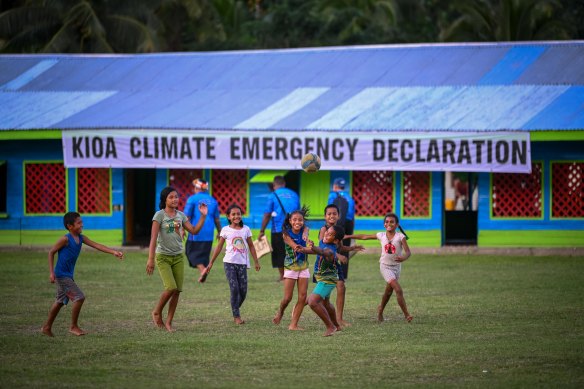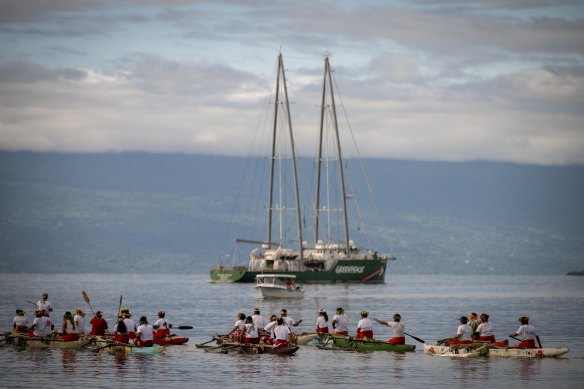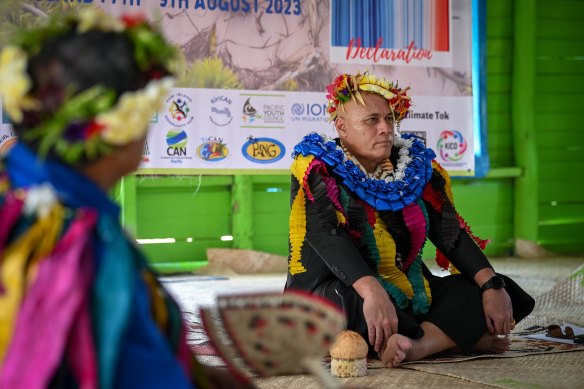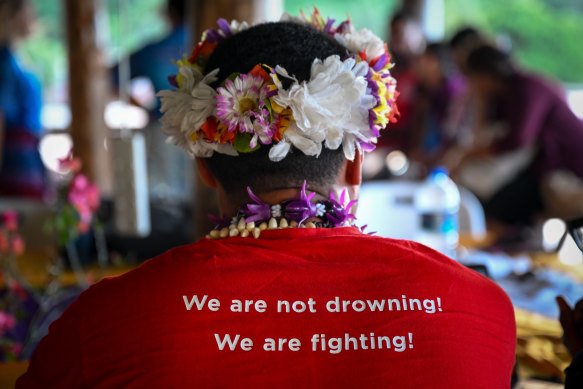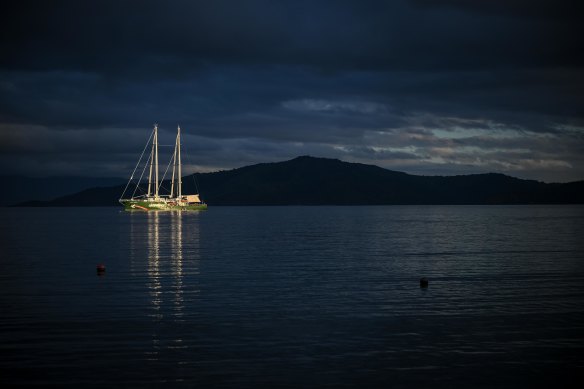By Miki Perkins and Eddie Jim
Kioa island resident Lotomau Fiafia and his grandson John. Lotomau was born on the island in 1952 and has seen erosion of the shoreline in the past decades. He stands in the water roughly where the shoreline used to be when he was young.Credit: Eddie Jim
Save articles for later
Add articles to your saved list and come back to them any time.
Esther Tulupe is worried. From the wooden verandah of her house on the remote Fijian island of Kioa, the crystalline waters of the Pacific Ocean are only a few metres away, past a low sea wall and a strip of blonde sand.
Already, when a king tide occurs during one of intense storms that increasingly batter these islands, the seawater rises over the sea wall and sluices under the floorboards of Tulupe’s family home. She fears for her four children when, not if, the sea comes higher.
“Before I had kids, it was like fun to me,” she says. “But when I had kids, especially when we listened to the radio about the tsunami [during Cyclone Winston] the council members announced to everybody near the shore, we have to move. We have to pack everything and run to higher place.”
Kioa resident Esther Telupe at her uncle’s house on the beach, next to her home. Construction was abandoned when it become clear it would be affected by sea level rise. Credit: Eddie Jim
Tulupe’s fears are shared by people across the Pacific region, who are on the frontlines of the stark, heartbreaking reality of the climate crisis, from Fiji to Kiribati, and Tuvalu to Samoa.
Rapid global warming is melting vast swaths of ice at the poles. The rising sea erodes coastlines, inundates land and poisons crops and water sources, while more frequent and unpredictable severe weather has disrupted seasonal rhythms.
Pacific leaders say climate change is the greatest threat to their region, and – through necessity – Pacific young people, climate activists, civil society organisations and governments have long been at the forefront of the global push for action.
Australia is now vying with Turkey to host a joint Australia-Pacific COP in 2026. Pacific governments have been broadly supportive of the proposal, but activists, less hobbled by the language of diplomacy, say Australia’s continuing extraction of fossil fuels renders its bid hypocritical. Many in the Pacific are calling on Australia, and other rich global emitters, to make urgent efforts to reduce emissions.
Children play soccer on the grass in Kioa. Credit: Eddie Jim
‘Severe and devastating’
At the beach in the village of Salia, on Kioa, a group of people wearing fou, or flower garlands, T-shirts bearing climate change messages and belts of dyed pandanus leaves slowly paddle a flotilla of wooden outrigger canoes out to greet a white motorboat.
Their strong voices rise in song across the tranquil water to welcome the boat’s passenger, the Tuvaluan Minister of Finance and Climate Seve Paeniu, who is also the Pacific Political Climate Champion for loss and damage.
Paeniu travelled to Kioa to launch an influential meeting of more than 60 civil society organisations, non-government groups and climate leaders and activists from across the Pacific last week. (Greenpeace facilitated travel to the Kioa for The Age and the Sydney Morning Herald.) He described Australia’s change of government and new climate legislation as encouraging, but said the Pacific and the Tuvalu government wanted to see these policies translated into concrete action.
For Paeniu and others at the meeting, the Albanese government’s target to reduce emissions to 43 per cent below 2005 levels by 2030 simply isn’t enough.
“The impact [of climate change] on our Pacific Island countries … is so severe and devastating that the large emitting countries and those companies that keep burning fossil fuel coal, oil and gas should step up and take more responsibility,” Paeniu said.
A flotilla of canoes give a traditional welcome to the Tuvaluan Minister for Finance and Climate Change, Seve Paeniu. Greenpeace ship The Rainbow Warrior is visible in the background. Credit: Eddie Jim
Pacific countries want Australia to bring in a moratorium on gas and oil extraction, and stop issuing new licenses for coal, oil and gas production, he said.
And they want Australia to support Pacific countries with technology and climate finance to facilitate their transition away from fossil fuel reliance: “We haven’t seen that from Australia yet. And that is our expectation,” Paeniu said.
The group came to Kioa last year for the first time to launch the “Kioa Climate Emergency Declaration 2022”, an urgent global call to action presented to the international community at COP27. And last week they met there again to create a regional loss and damages fund, a response to existing international finance mechanisms that are bureaucratic, constrained by red tape and delivered at a glacial pace.
At last year’s UN climate change conference (COP27), a “loss and damages” fund – to provide financial assistance to poor nations stricken by climate disaster – was finally agreed, three decades after the Pacific first raised the need for such a provision. Rich countries had resisted loss-and-damage finance, partly because of a fear of being hit with large claims. How this international fund and the regional Pacific one would interact is still being worked out.
The presence of Paeniu at the Kioa meeting is testament to the group’s clout, and the proposed regional funding mechanism will be presented to COP28 in November. This UN meeting is being controversially held in the United Arab Emirates, which controls about six per cent of the world’s oil reserves.
The Tuvalu Minister for Finance and Climate Change, Seve Paeniu, is welcomed to the Kioa meeting in a traditional ceremony. Credit: Eddie Jim
At the moment, a moratorium on fossil fuel extraction in Australia seems highly unlikely. Research from the Australia Institute found that federal government subsidies for fossil fuels reached $11.6 billion in the 2021-22 financial year. Australia’s Minister for the Environment, Tanya Plibersek, has approved at least three coal mine expansions this year.
Maina Talia, an organiser of the Kioa meeting and Tuvaluan climate activist, is blunt: “We had a lot of hope in the new [Australian] government, but opening new coal mines gives us a bad signal.”
Talia does not support the joint Australia-Pacific COP bid or accept that it might bring more global attention to the plight of his region. “Having this [lack of] commitment to the Pacific … on climate change is unbearable,” he says. “The world has known about this region a long time … we’ve been advocating on climate change for many, many years.”
A delegate at the meeting in Kioa to discuss creating a regionally-specific loss and damages fund for islands affected by climate change. Credit: Eddie Jim
A spokesperson for Australia’s Minister for Climate Change and Energy, Chris Bowen, said the government had passed reforms to the Safeguard Mechanism to ensure Australia’s largest emitters reduced their carbon pollution, the equivalent of 200 million tonnes of emissions reduction by 2030.
“The government is also rapidly increasing the share of renewable capacity in the electricity grid – with 82 per cent renewables by 2030,” they said.
Basket of treasures
From his small house on the hill above Salia, the only village on Kioa, Lotomau Fiafia can see the beach fringed by coconut palms and a stretch of grass where children play once the sun has sunk behind the steep hills.
Residents of Kioa are descendants of Vaitupu atoll in Tuvalu and began migrating to the Fijian island in the 1940s because of overcrowding. Kioa was chosen as location of the Kioa climate talks because it’s considered a successful model of dignified migration, which might be a blueprint for future climate change relocation.
Born in Kioa in 1952, Fiafia estimates the beach has lost 100 coconut trees, and around 75 square metres of coastline due to rising sea levels since the 1990s.
“More sand erodes each year. Rain does not come in its right time. We’re expecting that this is the dry season [but] more rain is coming … some of the crops do not favour this weather.”
It’s difficult to estimate how much the seas will rise. According to the Intergovernmental Panel on Climate Change, even if warming is limited to well below two degrees, global sea levels could rise by 2100 by 30 to 60 centimetres, but by as much as 1.1 metres if emissions continue to increase.
Pacific groups are not the only ones scrutinising the Australian government’s response to the climate crisis. Two Torres Strait community leaders are taking the government to the Federal Court, alleging it has failed to protect First Nations traditional owners living on the front line of catastrophic climate change.
After two days of talks in Kioa, the delegates launched the regional finance mechanism, the Kato Pacific Community Climate Fund, which they hope will remove barriers to vulnerable frontline communities trying to access climate crisis funding.
“Too many of our communities seem to be falling between the gaps when it comes to resources,” said Joseph Sikulu, the fund’s chair and 350.org Pacific director. Kato means basket in Fijian and Minister Paeniu said it symbolised the way in which Pacific people have traditionally planned for the future: “Putting a little away in a basket for rainy dates. The kete is therefore a life-saving basket of treasures for survival.”
Greenpeace’s Rainbow Warrior at anchor near the island of Kioa.Credit: Eddie Jim
Other climate action is under way in the Pacific. A group of young Pacific law students succeeded in March in getting the United Nations to back a landmark resolution on climate justice. The UN has asked the International Court of Justice to provide advice on whether countries have an obligation to protect the global climate system, and the court’s decision next year could have powerful worldwide legal consequences.
Greenpeace lawyer Katrina Bullock participated in the Kioa talks, accompanied by a group of Greenpeace climate advocates who travelled to the island on the Rainbow Warrior. Bullock also gathered personal stories from Kioa residents to present to the International Court of Justice.
“We feel that it’s important to take human rights stories from the Pacific to the court and remind the court why it matters,” she says. “One of the things I’ve learnt as a lawyer is that facts and figures are important, but what moves hearts and minds is stories.”
Esther Tulupe’s story is likely to be one of those presented to the UN, but she has other issues on her mind. Her family has met the village elders, who agree that one day Tulupe’s family will be asked to move further up the hill, but she fears it will be expensive. She can apply for a loan from the Fijian government, but it is a long, time-consuming and uncertain process.
Until then, her family will rely on their neighbours to help hammer wooden boards over the windows each time there is a cyclone warning. Everyone on Kioa helps each other through uncertain times: “It’s very good living here because we always work together.”
The bay at the village of Salia. The coastline has been eroded and many coconut palms have been lost in storm surges. Credit: Eddie Jim
The Age and The Sydney Morning Herald travelled to Kioa with assistance from Greenpeace.
Get to the heart of what’s happening with climate change and the environment. Our fortnightly Environment newsletter brings you the news, the issues and the solutions. Sign up here.
Most Viewed in Environment
Source: Read Full Article

